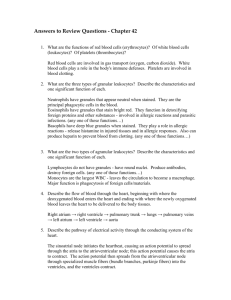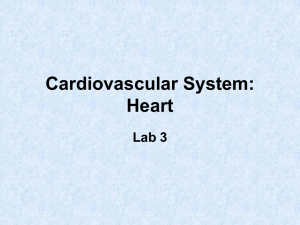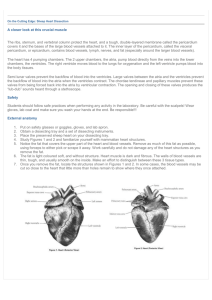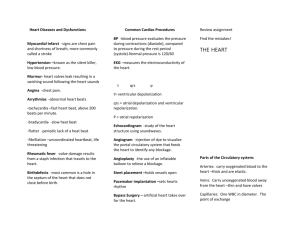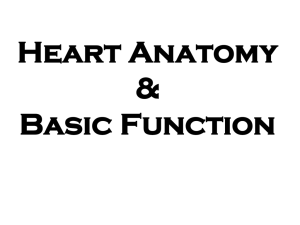The Heart Cardiovascular System
advertisement
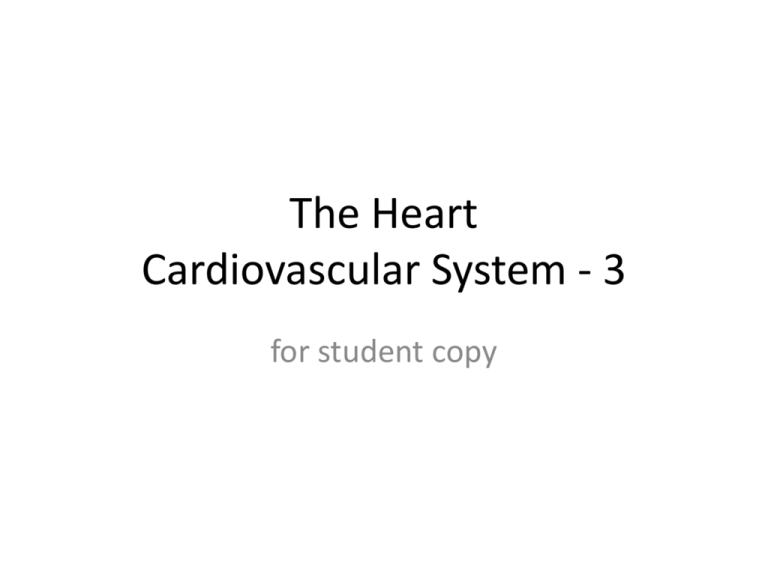
The Heart Cardiovascular System - 3 for student copy Position of the Heart • human heart is about the size of a fist • lies in the thoracic cavity w/in the mediastinum (area from sternum to vertebrae, between the lungs) • tilted @ angle so its inferior surface lies against the diaphragm Parts of the Heart • Base of the heart is its superior border • Apex of the heart is lowest point Major Heart Structures: the Pericardium • Outer Layer: Fibrous Pericardium – tough, attaches to diaphragm • Inner Layer: Serous Pericardium – dbl membrane: • outer parietal: attaches to fibrous pericardium • inner visceral layer: covers cardiac muscle – between the 2: pericardial cavity filled with serous fluid Wall of the Heart • 3 layers 1. outer epicardium – same as visceral pericardium 2. middle myocardium – cardiac muscle 3. inner endocardium – thin layer of endothelium that lines inside chambers of the heart & valves Surface Features of the Heart • 4 chambers of heart: – 2 atria form the base • Auricles (ear-like) pouch-like extensions – tip of left ventricle forms the apex – Sulci: grooves where coronary blood vessels & adipose tissue that externally mark the boundaries between the 4 heart chambers • coronary sulcus: separates atria from ventricles • anterior & posterior interventricular sulcus: separate 2 ventricles Right Atrium • Receives deoxygenated blood from SVC & IVC Right Atrium • inside surface has honeycombed appearance & ridges called pectinate muscles • wall separating rt & lt atrium= interatrial septum: in fetus hole called foramen ovale (blood shunts from rt atrium lt atrium avoiding pulmonary circulation); when scarred over called fossa ovalis Right Ventricle • receives blood from right atrium • sends blood to pulmonary trunk lungs to be oxygenated Right Ventricle • inside has ridges of muscles called trabeculae carnae: largest ones called papillary muscles: have string-like cords called cordae tendinae Right Ventricle • separated from left ventricle by: interventricular septum Left Atrium • receives oxygenated blood thru 4 pulmonary veins • delivers blood to left ventricle • seen on posterior surface of heart Left Atrium • thin-walled • identifiable characteristic: 4 pulmonary veins entering it Left Ventricle • receives oxygenated blood from left atrium • sends blood to systemic circulation thru Aorta • has thickest muscle (pumps blood the farthest) 4 Heart Valves • control 1-way flow of blood • 2 AV valves – between atria & ventricles – Tricuspid : rt AV valve – Mitral : lt AV valve, aka bicuspid • 2 semilunar valves – blood exits rt ventricle thru Pulmonary (semilunar) valve – blood exits lt ventricle thru Aortic (semilunar) valve AV Valves • Tricuspid valve • Mitral Valve Semilunar Valves • Pulmonary Valve • Aortic Valve Blood Flow thru the Heart • thinner walled atria receive blood returning to heart from veins • pressure of blood in filled atria opens the AV valves & most of the blood flows into ventricles • both atria contract simultaneously to pump remaining blood into ventricles Blood Flow thru the Heart • when atria have stopped contracting AV valves close • Ventricles contract together forcing semilunar valves open • walls of left ventricle thicker providing more force to pump blood thru systemic circulation Blood Flow thru the Heart • Ventricular Systole: – when both ventricles are contracting – AV valves close – Semilunar valves open • Ventricular Diastole: – when both ventricles relaxed – Semilunar valves close – AV valves open Cardiac Cycle Systemic & Pulmonary Circulation Heart Sounds • Auscultation: listening to body sounds • 1 heartbeat produces 2 heart sounds: lub-dub • heart murmurs: abnl heart sounds usually due to valve abnl • http://www.blaufuss.org/tutorial/ind ex1.html Pulse • when ventricles contract a blood pressure wave is produced that travels in the arteries and can be felt as your pulse • radial pulse: check over radial artery • carotid artery pulse: check over carotid artery Calculate Pulse • Count the # of beats in 15 s and multiply x 4 • If the math is too difficult count for 30 s and multiple x 2 Blood Pressure • pressure exerted by blood against blood vessel walls • highest in the aorta & large elastic arteries & decreases as arteries get smaller & further from heart Systolic Blood Pressure • top # on a BP • pressure generated by ventricular systole • normal adult: ~120 Diastolic BP • bottom # on BP • pressure exerted during ventricular diastole • normal adult: 60- 80 Arterial Blood Pressure • normal adult ~ 120/80 • normal venous BP: ~16 mm Hg BP • pump used to inflate cuff to a pressure > the systolic pressure: – puts pressure on the artery, flattens it, & stops blood flow in the artery – pressure slowly released from cuff as stethoscope used to auscultate over brachial artery BP • reported in mm Hg • as pressure in cuff becomes < pressure in artery…examiner will hear a sound can be heard, caused by the turbulent flow of blood as artery goes from flattened normal
